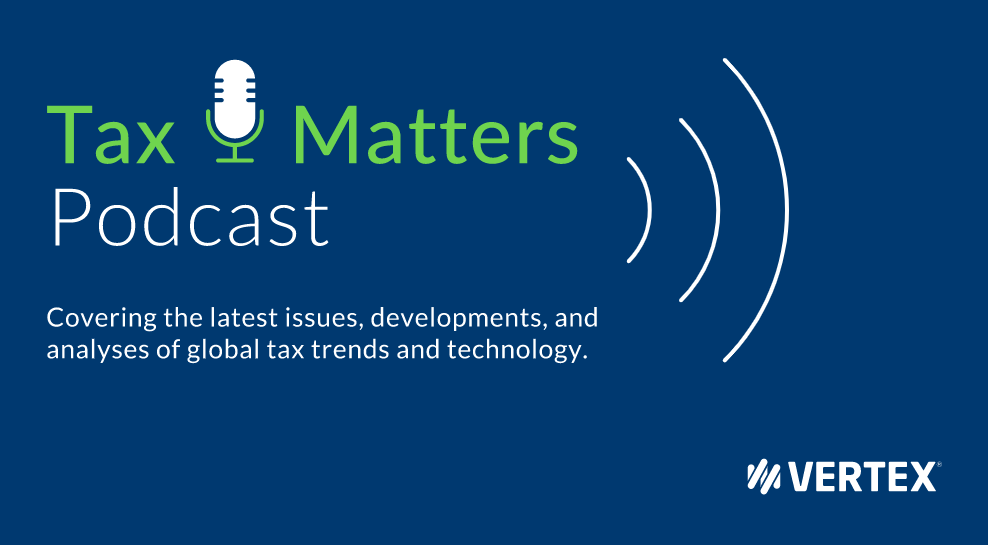Rachel Litcofsky: Welcome to Tax Matters, a Vertex podcast that brings you the latest insights and trends in the world of taxation! I’m Rachel Litcofsky, Manager, Public Relations.
In this episode, Vertex Vice President and Chief Tax Officer Michael Bernard shares an early rundown of Vertex’s 2025 Mid-Year Sales Tax Rates and Rules report. Mike and business writer Eric Krell discuss U.S. sales and use tax rate changes and the related trends shaping the landscape.
There’s a lot to unpack. The total number of rate and rules changes through the first five months of this year are 20% higher than the changes that occurred through the first six months of 2024.
Mike digs into those changes and then highlights the local, state, national and global factors influencing indirect tax policymaking.
Now, I’ll turn it over to Mike and Eric.
Eric Krell: Hello Mike, it’s good to reconnect with you. Are you ready to talk about rates and rule changes?
Michael Bernard: Eric, it’s always fun to visit with you on this topic. And, yeah, there’s a lot to talk about today, so looking forward to it.
Eric Krell: We want to let listeners know that the numbers we cover today are from the first five months of the year -- through May 31st. Vertex’s 2025 Mid-Year sales Tax Rates and Rules Report will be finalised in early July. The report will reflect changes that have occurred through June 30th. Let’s get to the numbers now: Mike, what strikes you when you look at the data?
Michael Bernard: Well, Eric, I think one of the things that you’ve seen is that there’s been a number of changes already through the first five months compared to the first five months last year. Sales and use tax continue to be a very dynamic way of raising funds – and of funding government. We definitely see that. Also, the pace -- if it continues -- would result in a record number of changes (for this past decade). We’ll see what happens in the future, but obviously we’re off to a strong start for 2025.
Eric Krell: Mike, on that note, tell me about the second half of the year -- why do there tend to be fewer policymaking changes with indirect tax in the last half of each year?
Michael Bernard: Most of the budgeting that’s been done for the year is based upon either some kind of late fiscal calendar or on a calendar basis, and the budgets have already been set. So, once the new taxes or the increases in taxes are instituted, at the beginning of the year through the middle of the year, those numbers have been run, and the budgets are well known. There typically is not a lot of activity going on after that point.
There are a couple of things I want to point out in terms of new district taxes. And again, Eric, when we think of districts, we’re thinking about parks and roads, police, fires and schools. Those new district taxes have essentially doubled for the first five months of this year compared to [the first six months of] 2024. In terms of new city taxes, that’s also doubled as well from about 30 to 60…From that standpoint, there’s been a lot of changes, and we’ll continue to see some changes, perhaps toward the latter part of the year.
Eric Krell: Why are so many more new district taxes coming online compared to district rate changes or even county and state rate changes?
Michael Bernard: I think what’s happened at the sub-state level is you’ve seen more and more jurisdictions take control of their own budgets and their own revenues…. A lot of these special districts have decided that they need more funding around what they’re doing. That explains some of what is driving district-level increases. That doesn’t mean that there aren’t substantive changes as it relates to cities; there are. And there tends to be fewer rate changes at the state level simply because there are more avenues for taxation at the state level. But you’re definitely seeing a lot more changes among districts.
Eric Krell: That said, it does seem like more states are making other tax policy changes. Can you talk about how some states are trying to expand their tax base?
Michael Bernard: One of the things that we’ve talked about in the past is when Wayfair became law and was broadly used and interpreted across this country, we thought that there would be a lot more taxation on services. Well, that hasn’t really happened to the extent that was expected. About seven or eight states now tax services, but many states do not. And keep in mind that between 40% to 60% of the U.S. economy, depending on which agencies you get your numbers from, consists of services. So, a large portion of the economy isn’t subject to sales and use tax. A big part of that is healthcare, childcare and eldercare. Obviously, most states have a policy issue in that they’re not going to tax those services because it’s highly regressive to do so.
Take those services out of the mix, and it gets down to professional services, personal services and things like reporting and data services. Over the last couple years, we’ve seen some states like Kentucky and Louisiana – and now this year, Washington State -- starting to tax professional services. This is a new avenue.
Next, as it relates to Maryland and Texas, states are starting to broadly tax digital services, such as streaming and educational services. You’re starting to see sales tax applied to those as well, and this gets to the Multistate Tax Commission (MTC’s) work on a uniform approach to digital taxation. Maryland’s new tech tax applies to data hosting, computer system designs and related services. You’re going to see more and more states starting to tax those kinds of services. I think that’s one place where the states are actually going to start increasing their tax base.
And Eric, as you and I have talked about in the past, the tax base today is about as small as it’s been over a 60-year period, mostly because there’s been a lot of exemptions. One factor behind all of the rate increase we discuss is the fact that the base has been shrinking.
Eric Krell: The focus on expanding the tax base is not only occurring in the U.S. but also globally, where e-invoicing mandates are a big issue. What are some of the challenges facing companies doing business in countries with e-invoicing and real-time reporting rules?
Michael Bernard: The folks in our audience should know that e-invoicing probably is not going to occur here in the United States. It is more of a phenomenon outside the U.S. – a way for other nations to develop a compliance system with more transparency. The first thing to know about e-invoicing is that there are a couple of different models. One is an information model where a company issues an invoice, sends it to the government, the government does some cursory checks to it and then sends the invoice back. At that point, the company is able to actually ship that good. Another approach is called a clearance model where you can’t ship those goods out until the invoice goes to the government, which subjects it to a more stringent set of checks. Once that review is completed and the information is received from the government that it’s okay, the company can ship the goods.
Another point is that a lot of the work on e-invoicing rules is unilateral. In other words, different countries have their own set of data that needs to be transferred from the seller to the government. That makes compliance very difficult if you operate in multiple countries [with e-invoicing rules].
Third, a lot of the e-invoicing compliance work so far has been IT-driven because compliance requires substantive work around ERP systems and sales systems. Now, tax is right there with IT because obviously all this information goes to tax authorities. Tax needs to make sure that the proper data is being sent.
Lastly, there is an emphasis on accuracy when you’re sending invoices directly to the government. You want to get it correct right away as opposed to correcting errors when you’re doing your reporting, say, a month later. Again, there’s a huge emphasis on being right the first time. This creates a lot of work for tax departments and for other places in the organisations, such as AP, AR and IT. This work is going to continue to be quite substantive over the next, say, three to five years.
Eric Krell: I asked you to look globally. Now, I want to ask you to look into your crystal ball. Looking ahead to the second half of this year, what factors do you think might have impacts on indirect tax rates and rules?
Michael Bernard: I want to start with property taxes, which have risen dramatically for a lot of individuals, so much so that homeowners in some states are having a tough time paying their property taxes. So, in the latter part of the year, you’ll probably see some ballot initiatives that limit the rise in property taxes. In many counties, up to 70% of revenues come from property taxes. If property tax limits result in a decrease in government funding, and if funding does not keep pace with inflation and spending, those tax districts are going to make up for the difference with sales tax rate increases.
The second thing is that I want to mention what happened with the Big Beautiful Act. As it stands, the act calls for substantive cuts to Medicaid and the SNAP program, which fund state programs. A report put out by the Tax Policy Center indicates, to make up for these cuts, many states are either going to have to raise their corporate and personal income tax rates by about 1%. Or, if they have a state sales tax, the states will need to increase their sales tax rate by anywhere from 0.8% to 2% . So, there could be significant impacts at the state level, whether it’s in the income tax area or whether they decide to fund those things from the sales tax area.
Lastly, legal cases related to tariffs and those federal matching funds have not been resolved yet. Those cases are moving on separate tracks through the federal courts, and much of that litigation is going to be decided over the next six months or so. If tariffs can stay in place according to the courts, they could suppress consumer spending. Again, those two areas -- tariffs and federal matching fund cases – could ultimately be decided by the Supreme Court, probably in the late 2025 or early 2026 timeframe.
Eric Krell: So, a lot of unknowns to be determined. I look forward to connecting with you again at the end of the year or in early January to see how this all plays out. Thanks so much Mike.
Michael Bernard: Thanks, Eric. Obviously, it’s a very dynamic time in the area of taxation. I look forward to getting back together with you soon.
Rachel Litcofsky: Thank you for listening to Tax Matters, a Vertex podcast…Check back here for more episodes soon.
This transcript has been edited for clarity.


